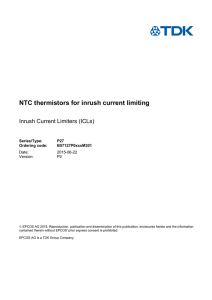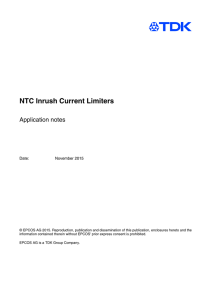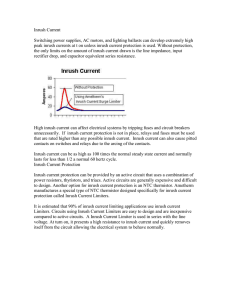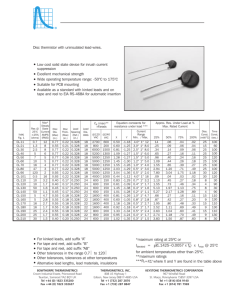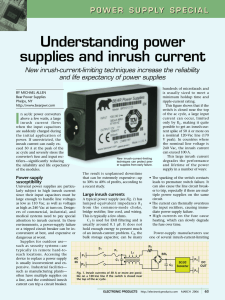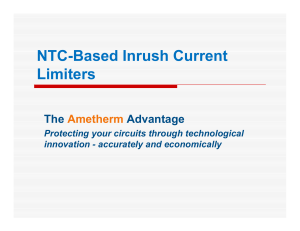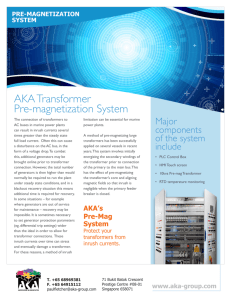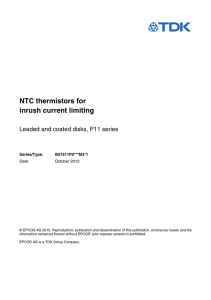NTC thermistors for inrush current limiting, application note
advertisement
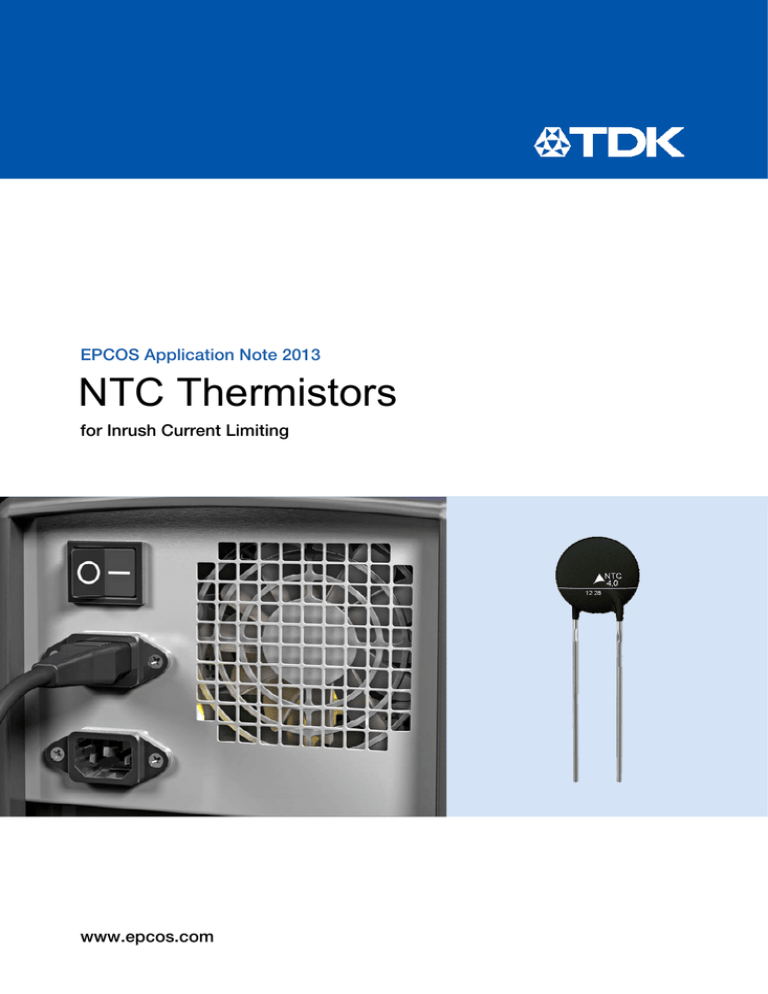
EPCOS Application Note 2013 NTC Thermistors for Inrush Current Limiting www.epcos.com NTC Thermistors for Inrush Current Limiting Like all NTCs, NTC thermistors for inrush current limiting are made of polycrystalline mixed-oxide ceramics. They suppress the high inrush current surges occurring in cases such as the charging of low-impedance smoothing capacitors. Why limit inrush currents? High inrush currents occur when many items of electrical equipment such as switched mode power supplies, motors, transformers and amplifiers are turned on. These currents can damage individual components or entire subassemblies and blow fuses in error. Such high currents are caused by the extremely low impedance of smoothing capacitors or coils which almost produce short circuits at the moment of switching on. NTC thermistors acting as inrush current limiters solve this problem without elaborate circuitry at low cost. What is an NTC thermistor? The resistance of negative temperature coefficient (NTC) thermistors falls as their temperature rises (Fig. 1). NTC thermistors are made from various metal oxides that are combined into a powdery mass and mixed with a plastic binding agent. In the production of inrush current limiters, the mass is pressed into disks under high pressure. Polycrystalline NTC thermistor bodies are formed by subsequent sintering of these blanks at temperatures between 1000 and 1400 °C. A silver paste is baked onto them as metallization on both sides. The disks are then leaded and sealed in varnish. Fig.1: Resistance/temperature characteristics (Parameter: B value) inrush current limiters is thus negligible in continuous operation – an outstanding advantage of NTC thermistors over fixed resistors. NTCs may be used in switched mode power supplies on the AC or DC side of the circuit (Fig. 2). Applications Switched mode power supplies Motors Transformers Amplifiers Monitors Color television sets Advantages Minimize line-current distortion and radio noise Protect switches, rectifier diodes and smoothing capacitors against premature failure Prevent fuses from blowing in error How does the protection work? In the cold state, i.e. at room temperature, the high initial resistance of the inrush current limiter effectively absorbs the power of peak inrush currents (Fig. 3). As a result of the current load and subsequent heating, the resistance of the inrush current limiter then drops by a factor >30 - 50 to a few percent of its value at room temperature. The power consumption of the © EPCOS AG Fig. 2: Possible locations of NTC inrush current limiters Resuming operation after cooling down After a load has been switched off, the NTC thermistor must be allowed to cool down to room temperature if its capacity for inrush current limiting is to be fully used. This can take from 30 seconds to two minutes depending on the disk size. In the case of switched mode power supplies, these cooling times are often a minor consideration because electrolytic capacitors in the circuit usually take longer to discharge fully. The NTC thermistor will therefore be cool enough to resume operation in the event of another short-term turn-on. 2 NTC Thermistors for Inrush Current Limiting Selection of inrush current limiters There are three major criteria for selecting the best inrush current limiter for an application: Rated resistance (R25) Maximum permissible continuous current under rated operating conditions (Imax, DC or RMS values for AC) Maximum capacitance CT to be switched The rated resistance is a measure of the damping of inrush current. Under rated operating conditions after stabilization, the maximum continuous current must under no circumstances be exceeded. Otherwise the component can be both thermally and electrically overloaded and thus destroyed. The test method shown in Fig. 4 is used to indicate the pulse strength. A capacitor CT discharges across a series resistor RS and an NTC thermistor. The charge voltage VC is selected so that the voltage VNTC applied to the thermistor at the start of discharge is 345 V, corresponding to (230 V + V) x . The capacitance CT indicates the energy absorption capacity and thus the pulse strength of the NTC thermistor. Fig. 3: Typical current characteristic on load after turn-on The maximum capacitance to be switched represents a criterion for comparing the level and duration of the current pulse at the moment of turn-on at which the inrush current limiter can be loaded without sustaining damage. Knowing the capacitance CT allows an NTC thermistor to be scaled for optimum cost and geometry (space requirement). However, different CT values can be compared only if equivalent test methods are used to determine them (see Fig. 4). A particular rated resistance R25 can be implemented in disks of different sizes. This means that for the same value of R25 different figures can be obtained for continuous load and pulse strength. So by referring to test patterns, the user can decide which inrush © EPCOS AG current limiter is best suited to the application. As a rule of thumb, the larger the diameter of the thermistor, the higher is the current in continuous operation. This also applies to energy absorption capability and pulse strength at the moment of turnon. Load derating The maximum continuous current rating (100% = I/Imax) is specified for EPCOS inrush current limiters at 0 °C ~ 65 °C. (The only exception is the S237 series, which is specified with a 100% current rating at 0 °C ~ 25 °C). So derating is only necessary at temperatures above 65 °C (S237 above 25 °C). In many applications, the temperature in the casing of the device is below 65 °C. NTC resistance at continuous current The effective resistance for the usual current change can be approximated as follows: RNTC = k x In [] 0.3 x Imax < I ≤ Imax Resistance value to be determined at a RNTC current I k, n Fit parameter, see individual data sheet of inrush current limiter I Continuous current flowing through the NTC The continuous current I in the application should be between 30% and 100% of the specified maximum continuous current Imax. The calculated values only serve as an estimate for operation in still air at an ambient temperature of 25 °C. This equation yields sufficiently accurate results for the limited current range stated above. Precautions For inrush current limiting, the NTC must be connected in series with the load circuit. Several limiters can also be connected in series for higher damping. Inrush current limiters must not be connected in parallel. If connected in parallel, the NTC thermistor with the smallest rated resistance consumes almost the entire current in the circuit and the resulting overload could destroy the component. In general, inrush current limiters need time to return to their cold state in which they can provide adequate inrush current limiting due to their high 3 NTC Thermistors for Inrush Current Limiting resistance. The cooling-down time depends on the ambient conditions. It should be noted that the surroundings of an NTC may become quite hot. Quality features of EPCOS inrush current limiters Extensive quality assurance systems guarantee a consistently high standard of quality. Siemens Matsushita Components manufactures NTC thermistors at its plant for ceramic components in Deutschlandsberg, Austria, which complies with the requirements of QS9000. Production is monitored by statistical process-control methods. The electrical and mechanical parameters of these thermistors are checked at the end of each production step as part of a comprehensive quality assurance procedure. Special methods of aging are also applied to ensure the high stability of their electrical characteristics. Reliability Reliability data for inrush current limiters is certified in accordance with IEC 68-2-2, 68-2-3 and 68-2-14. Tests are conducted under cyclic and continuous (1000 h) maximum loads. The currents during turn-on are much higher than the rated currents during continuous operation. The pulse strength of an NTC is also evaluated. EPCOS uses standard procedures to test the effects of these current surges (Fig. 4). R tolerance ±10% possible High energy absorption capability at moment of turn-on Lower power loss during normal operation Various lead configurations available Range of EPCOS NTCs for inrush current limiters A wide range of EPCOS NTCs for inrush current limiting with different designs and resistances allows optimum matching to the most varied applications. It extends from the S153, the smallest model with a diameter of 8.5 mm for a maximum continuous power rating of 1.4 W, up to the S464 with 26 mm and 6.7 W respectively. The resistance ranges from 1 to 80 . The maximum permissible continuous current Irms extends from 1.3 A (S153) to 20 A (S464). Table 1: Main parameters of EPCOS NTCs for inrush current limiters R25: Imax: Pmax: NTC resistance at 25 °C Maximum permissible continuous current (DC or RMS values for AC) Maximum power rating at 25 °C : Dissipation factor th Fig. 4: Test circuit for evaluating the pulse strength Features QS9000 certified UL approved (E69802) High reliability (IEC 68-2-2, 68-2-3, 68-2-14 approved) Wide product range Diagram 1: Selection criteria for inrush current limiters: resistance at 25 °C and rated current Important information: Some parts of this publication contain statements about the suitability of our products for certain areas of application. These statements are based on our knowledge of typical requirements that are often placed on our products. We expressly point out that these statements cannot be regarded as binding statements about the suitability of our products for a particular customer application. It is incumbent on the customer to check and decide whether a product is suitable for use in a particular application. This publication is only a brief product survey which may be changed from time to time. Our products are described in detail in our data sheets. The Important notes (www.epcos.com/ImportantNotes) and the product-specific Cautions and warnings must be observed. All relevant information is available through our sales offices. © EPCOS AG • A Member of TDK-EPC Corporation Edition 2013 • Printed in Germany
